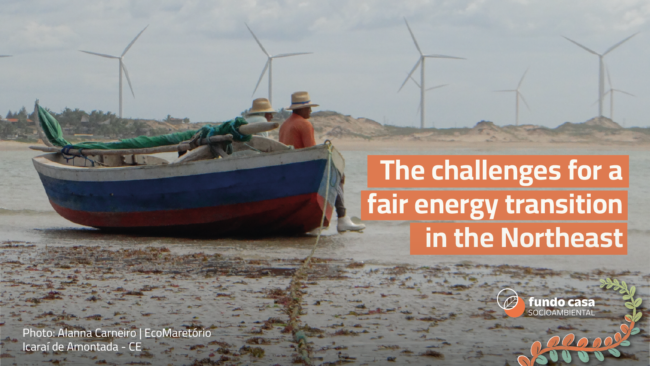 01.03.2023
01.03.2023
The challenges for a fair energy transition in the Northeast
The haste of the climate emergency cannot be a justification for disrespecting the rights of local and traditional communities
By Attilio Zolin/ Casa Socio-Environmental Fund
The energy transition is urgent and necessary. Humanity needs to reduce its dependence on energy sources of fossil origin and migrate to other sources that emit less greenhouse gases. The change is essential to prevent the planet’s average temperature from continuing to rise, causing even more devastating effects on ecosystems and also on populations most vulnerable to the impacts of extreme weather events.
The world looks to renewable sources as a solution, and so do investors. The sector should receive billionaire figures in the coming years, with great support and encouragement from local governments that wish to receive these resources. According to the Energy Transition Investment Trends report by the US magazine Bloomberg, international investment in energy transition reached US $755 billion in 2021, growing by almost 30% in the following year. In the midst of all this, Brazil stands out as a destination for these resources, especially the Northeast region, which has abundant sunlight all year round and a lot of wind along its coast, perfect conditions for generating solar and wind energy.
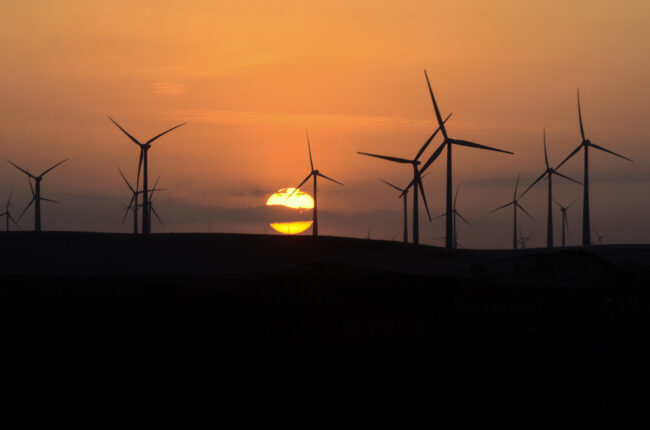
Sunset in Enxú Queimado, a fishing community affected by speculation related to wind energy projects. Photograph: Joelma Antunes.
Recently, on a visit to Brazil, German Chancellor Olaf Scholz announced his country’s great interest in Brazilian renewable energies, announcing an unprecedented partnership between the countries for the production of green hydrogen, a type of fuel that can be exported to help the Germans face the current energy crisis without compromising their climate targets. The expectation is that green hydrogen will move a market of 1 trillion dollars in the world. In Brazil, exports are expected to reach R$150 billion. The first green hydrogen plant in Brazil has already started production in São Gonçalo do Amarante, Ceará, and another plant is being built in Bahia.
However, little is said about the impacts that large renewable energy projects are causing in local and traditional communities. In strategic regions for the implementation of solar and wind farms, such as in the Brazilian Northeast, there are countless cases of disrespect for the rights of these communities, which are not frontally opposed to the energy transition, but demand that the transition be carefully thought out. Casa Socio-Environmental Fund and its partners are looking for ways to make the much-needed energy transition fair for everyone, including the environment and the communities that live in these territories.
Seeking to strengthen the dialogue and provide information on the subject, four civil society organizations came together to create a collective initiative that discusses and analyzes various aspects that involve the implementation of renewable energy projects in the Northeast. The joint work between Centro Brasil no Clima, Casa Socio-Environmental Fund , Bahia Environmentalist Group and InfoClimate Institute, with support from Climate and Society Institute, resulted in the creation of the Northeast Potency Plan. Created in 2022, the Plan aims to promote public debate on the post-pandemic economic recovery in the Northeast under green, fair and inclusive bases, in a system that brings benefits to all strata of society.
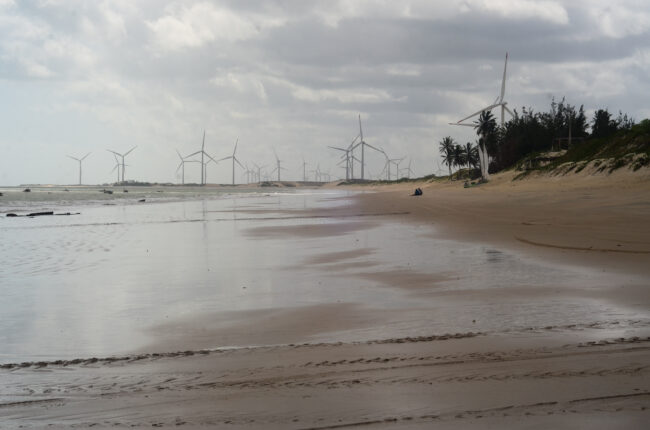
In Rio Grande do Norte alone, there are almost 3 thousand turbines in operation, which form a veritable sea of weather vanes on the horizon. Photograph: Joelma Antunes.
According to the Plan, the enterprise undertakings granted in the Northeast region by the federal government represent 66 GW, almost 5 Itaipus (third largest hydroelectric dam in the world) of energy power. Of this total, part is related to the production of photovoltaic energy (solar) and most of it should come from wind power. There is also the expectation that the equivalent of 3 more Itaipus can be added in offshore wind farms, which are towers installed directly in the sea. The Plan advocates, for example, that local environmental impacts are assessed and mitigated. Degraded and abandoned areas, when not priority for recovery, conservation and traditional use, should be chosen to receive new power stations and transmission lines. Environmental licensing must consider future scenarios for the region, in addition to working with the best and most recent existing technology.
The Plan also defends the urgent revitalization of the São Francisco River basin. The river is key to the expansion of renewables and hydroelectric plants serve as a complement to variable or intermittent sources, such as wind and solar. About 50% of the river’s natural water surface has disappeared in the last 30 years and 3.3 million hectares need to be recovered in legal reserves and APPs in its basin. Maintaining the waters of the São Francisco is also important to maintain the clean profile of greenhouse gas emissions in the Brazilian electricity sector, preventing the entry of thermal power plants based on fossil sources, such as gas and coal, to compensate for periods of water crisis.
How large wind farms impact local and traditional communities in Northeast Brazil
Currently, Brazil already has more than 800 wind farms and almost 10 thousand wind turbines in operation. In Rio Grande do Norte alone, there are almost 3 thousand turbines that form a veritable sea of weathervanes on the horizon, a curious landscape to say the least that can yield interesting photos, but for many local residents, this view is a real nightmare.
A recent example of poor planning and disastrous consequences involving renewable energy projects are hydroelectric dams in the Amazon. With a discourse that preaches the production of “clean energy”, the construction of these hydroelectric plants was carried out using methods that were not clean, causing profound and irreparable impacts on the ecosystems and on the lives of indigenous and riverside communities that lived in harmony with the forest and rivers, flooding huge areas of forests and even generating large amounts of greenhouse gases in the process. This disastrous model, given the due proportions, is being reproduced in the Northeast, where we see the repetition of the same pattern of disrespect for communities and the environment.
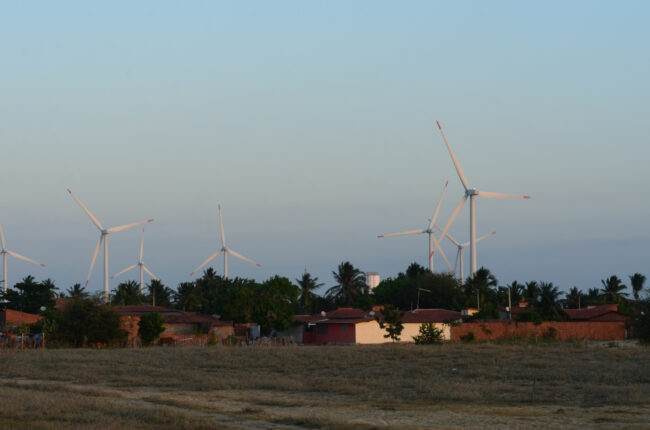
In some cases, wind turbines are dangerously close to communities, generating a series of impacts on these populations. Photograph: Joelma Antunes.
For Renato Cunha, an engineer specializing in environmental management and energy planning, “it is essential to work on the energy transition at the current moment of the planet, but this transition has to be done with greater care, everything has to be done with transparency and participation of the communities”. Renato is also Executive Coordinator of the Environmentalist Group of Bahia, Gambá, in addition to being the current President of the Casa Fund Deliberative Council. Most renewable energy projects already start out making mistakes, and do not take into account human rights and nature, according to Renato, “it is not identified that there are communities there, there are people who live and work in that territory, that there are natural springs, biodiversity, and that in order to implement the project, this life present in the territory will be impacted. The first thing that needs to be done is to identify these impacts, and this has not been happening.”
Many wind farms were installed dangerously close to inhabited places and the excessive noise and constant lights can cause in residents what some scientists have already named as “wind turbine syndrome”. This syndrome can cause symptoms such as: insomnia, nausea, headaches, among others. The reports of local residents also describe impacts caused on migratory birds, schools of fish, bees and other animals that apparently feel frightened by the huge blades of the turbines and towers that can reach more than 80 meters in height.
At the moment, one of the biggest expansion fronts for wind energy in the Northeast is offshore projects, in which the towers will be fixed directly to the bottom of the sea. The installation of these turbines will be done in places where the sea is not so deep, precisely in the areas where artisanal fishermen usually use for their fishing. Despite being unprecedented in Brazil, negotiations and authorizations for this type of project are already at an advanced stage, what is not yet known is the size of the impact that this new model will bring to the region and to the fishing communities.
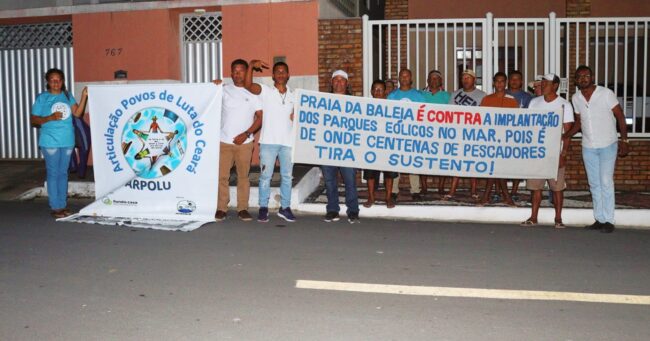
Fishermen take part in an action at the Itapipoca City Council, in Ceará, taking a stand against the implementation of wind farms at sea. Photograph: Vylena Souza.
Offshore projects overlap with artisanal fishing territories, and this will affect the dynamics of several traditional fishing communities, impacting on the traditional way of life and threatening the food and financial security of these families. These territories are fundamental for the existence and nourishment of these communities, just as they were for their ancestors who established themselves there. The inability to access important fishing grounds could result in the eviction of entire communities from their territories.
It is expected that many jobs can be created in the Northeast in the coming years with the expansion of wind and solar plants, however, this supposed benefit is also an argument questioned by local communities. The developments generate many immediate jobs in their construction, but most are temporary vacancies and the offer decreases as soon as the works are completed. With the plants in operation, the work offered is aimed at extremely qualified professionals, such as engineers and technicians, who often come from other cities or countries. In addition, the large movement of workers in regions previously considered peaceful, brings with it social problems that did not exist in the communities before, such as violence and prostitution.
Pathways to a fair transition
At the same time that the projects advance, local organizations seek to bring information to empower communities, as is the case of Coletivo Cirandas, which with the support of Casa Fund is carrying out collaborative mapping in communities that are in coveted territories for energy generation. Collaborative mapping is a social and participatory cartography technique, in which community members themselves help to map their territory, according to their traditional knowledge passed down from generation to generation. With this mapping in hand, the community is better prepared to develop strategies to defend the fishing territories.
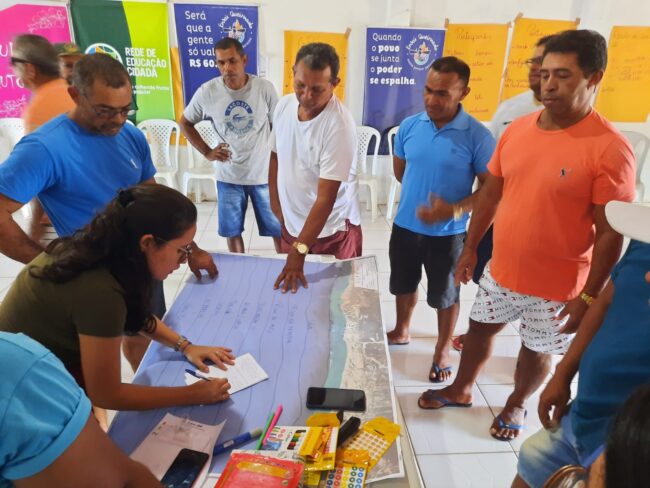
Conducting collaborative mapping with fishermen in Enxú Queimado, in the municipality of Pedra Grande, on the Rio Grande do Norte coast. Photograph: João Paulo Diogo.
According to João Paulo Diogo, one of the coordinators of Coletivo Cirandas, the contracts implemented by wind farms that were analyzed are “incompatible with socio-environmentally responsible energy production models”. Among the impacts caused in the communities, João mentions the limitation of the residents’ access to important places for the maintenance of their traditional way of life, compromised cisterns, impacts on the local fauna and also interference caused by the towers that affect the communication via cellular and also the open TV signal.
For João, “companies and the government must think about the sector together, construction business agreements and rules that provide a safe and sustainable environment for the wind energy production sector”. Civil society demands that safeguards be built to protect communities from aggression, compensation for communities that have already been impacted, and also mitigation plans to remedy damage to the environment. To date, little or nothing has been done in this regard. These defense and care mechanisms need to be discussed and built jointly and with the participation of the communities, this is what Casa Fund and its partners are currently working on, seeking participatory solutions to the enormous challenges.
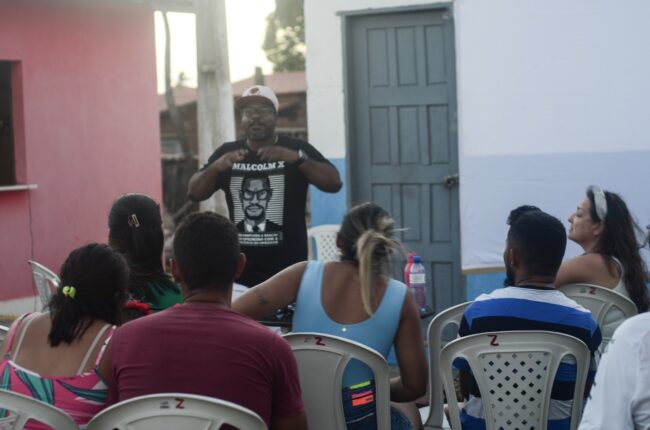
João Paulo Diogo, is one of the coordinators of Cirandas, undergoing a master’s degree in Urban and Regional Studies (UFRN) and Specialist in the Rights of Traditional Peoples and Communities (UFBA). Photograph: Joelma Antunes.
Among the social participation tools that have already been raised and are suggested by the Northeast Potency Plan are the creation of permanent forums for debate and direction for the installation of solar and wind power plants, the guarantee of identity and permanence rights over the territory, the democratization of information on projects and transmission lines and the definition of new indicators and chains of responsibilities for power plant installation service providers in dialogue with society. Compliance with these conditions is essential so that the expansion of wind and solar parks does not provoke and repeat injustices and the violation of rights (commonly witnessed in the fossil fuel energy operations).
And finally, it is necessary to think of other solutions, alternative paths, especially those involving decentralized production, to make it easier for more and more people to have local electricity production systems in their homes, either through photovoltaic panels on their roofs or small wind turbines. Not only in homes, but also in public buildings and businesses of all sizes, including rural ones. These decentralized initiatives can also contribute to the generation of fairer and more lasting jobs, training and empowering local populations. If the energy transition is inevitable in times of climate emergency, disrespect for communities can and should be avoided. There needs to be dialogue, listening and participation so that the new energy matrices are truly fair for everyone. The challenge is set, it is up to us to build the solutions.
